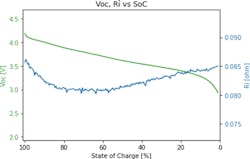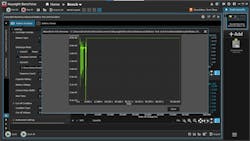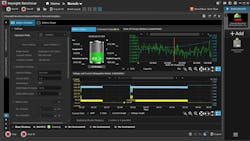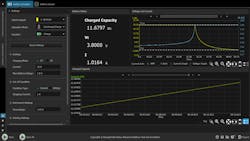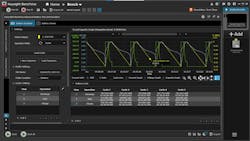How to Design for Longer IoT Battery Life with Emulation Software
Members can download this article in PDF format.
What you’ll learn:
- Profiling batteries through charging/discharging to create unique battery models for emulation.
- Emulating charge states to reduce test time, improve safety, and gain insight to extend battery life.
- Automating the charging and discharging of batteries to determine capacity.
- Cycling batteries to determine capacity loss and battery life reduction.
The Internet of Things (IoT) has led to an extraordinary transformation of consumer electronics and industrial applications. IoT enables intelligent, interconnected operations, changing everyday devices into smart systems that enhance efficiency and user convenience. However, the success and utility of IoT devices hinge on their battery runtime.
Consumer IoT devices, from smartphones to wearables, have transformed our daily lives, providing unparalleled convenience to enhance living standards. Yet, the user experience with these devices depends on battery life. Longer battery runtimes reduce charging frequency, providing a seamless, uninterrupted user experience.
In the industrial sphere, IoT devices are integral in streamlining operations, improving safety, and enhancing productivity. These devices often operate in remote, hard-to-reach, or harsh environments, making regular battery replacement or recharging unfeasible. Therefore, long battery life is essential for continuous, reliable data collection and system operation.
Emulation software lets you gain rapid insight into your IoT device’s current drain and lengthen the battery runtime. In addition, battery emulation and profiling software enables you to accurately predict battery life and aging effects.
Profiling Batteries to Create Unique Battery Models
Profiling and characterizing batteries helps you understand the amount of energy they can store and supply without needing a physical battery. A battery model created with profiling software maps out the open circuit voltage and internal resistance versus the state of charge (SOC). It’s crucial to map out these characteristics for battery models to accurately reflect real-world performance. Figure 1 provides an example of a typical plot.
Confirming the battery’s performance under specific discharge conditions and operating modes is also essential. Parameters that affect battery behavior include:
- Temperature
- Load current profiles (constant/dynamic)
- Operating modes, including constant current, power, and resistance
Therefore, creating different battery models to match specific discharge conditions is vital.
Emulating Charge States to Reduce Test Time and Gain Insight to Extend Battery Life
Why use a battery emulator instead of a battery for device testing? There are several reasons:
- To create a safer test environment. It’s not necessary to charge and discharge batteries when using an emulator. Charging and discharging batteries can become dangerous with repeated cycles.
- To achieve repeatable results. The characteristics of emulated batteries don’t vary, while the characteristics of physical batteries can fluctuate after charging/discharging. Characteristics can also vary between batteries, even if they’re the same model.
- To reduce test setup times. Instantly simulate any SOC rather than manually draining a battery to the desired level.
A battery emulator works in multiple steps. The first step is loading a battery model that comprises the plot of the battery voltage and internal resistance versus the SOC (Fig. 1, again). You can create a battery model using battery profiling software or by receiving a profile from a battery supplier.
When using profiling software, the model will reflect the current consumption for a specific device, which is more accurate than a battery supplier’s generic profile. For example, a generic profile isn’t helpful if the battery supplier creates the profile based on a constant current draw when the device consumes a dynamic current.
Figure 2 shows a device’s current consumption profile loaded into a battery profiler. The software keeps repeating the waveform until it completely drains the battery and maps out a full battery model.
The next emulation step is to select the starting SOC and the cutoff voltage. Connect the device to the emulator and start the battery emulation.
Battery emulators continuously measure the current, charging or discharging, and dynamically calculate emulated SOC. The emulator continuously changes its output (voltage and resistance) based on the SOC to conform to the loaded battery profile (Fig. 3). If the emulator is discharging, the test ends when the emulator reaches the cutoff voltage.
Emulating a battery at different SOCs provides deep insight into a device’s behavior. Figure 4 shows insight into a device’s current drain. You can quickly assess the effect of design or software changes and optimize your design to extend battery runtime.
Automating Charging/Discharging of Batteries to Determine Capacity
It’s necessary to understand the energy a battery can store and deliver for IoT devices. Battery test and emulation software simplifies this process by automating battery charging and discharging to determine capacity.
Software must support constant-current (CC) and constant-voltage (CV) modes for charging batteries. As the battery reaches full capacity when charging using CC mode, the software needs to move from CC mode to a combination of CC and CV. This combination is necessary because you can’t charge a battery at the same rate when it gets close to peak voltage or capacity.
You can use constant-current, constant-resistance, and constant-power modes to discharge a battery. However, you can achieve a more accurate capacity estimate using a dynamic current waveform for battery discharge.
Battery test software makes it possible to create a current-consumption profile directly from a device (Fig. 5). You can then use the profile to drain the battery via software to achieve a real-world estimate. Simulating this with the actual device is difficult as you must operate it throughout the rundown test. Therefore, it’s much more practical to automate this process with software.
Cycling Batteries to Determine Loss of Capacity and Reduction of Battery Life
Battery performance can decline significantly over a lifetime of charging and discharging. This is why it’s vital to simulate battery cycling. A battery cycling software solution must support the ability to create varying charging and discharging profiles.
The software can then combine disparate sequences to simulate complex charging and discharging cycling profiles (Fig. 6). Then you can confirm how a battery’s performance degrades over time. Emulation software solutions are ideal for this as they can enable, for example, up to 1,000 cycle operations to determine the battery’s aging effect and reliability under sequence test conditions. Software must offer data-logging capabilities to store all of the data.
Summary
Current drain and battery rundown testing present many challenges. The manual process of charging and discharging a battery is time-consuming, but testing your device at various charge levels is crucial due to varying battery characteristics.
Furthermore, battery parameters and charge levels must be identical when comparing test results. Achieving this is challenging with physical batteries. In addition, it can be difficult to determine how long a device can last on a single charge, and often battery life claims don’t match reality.
Using an emulated battery can help you overcome these difficulties. First, a battery model provides a known-good reference, boosting trust in your test results. Plus, you can quickly assess the effect of design or software changes on battery life by instantly transitioning the battery’s charge state. These abilities enable you to enhance your designs to achieve longer battery life and smaller size.
On top of that, a software solution enables you to accurately estimate battery life by automating battery rundown using the simulated device’s current drain. This method is more accurate than using constant current to drain a battery. The automated process is also more straightforward than manually draining a battery through device usage.

